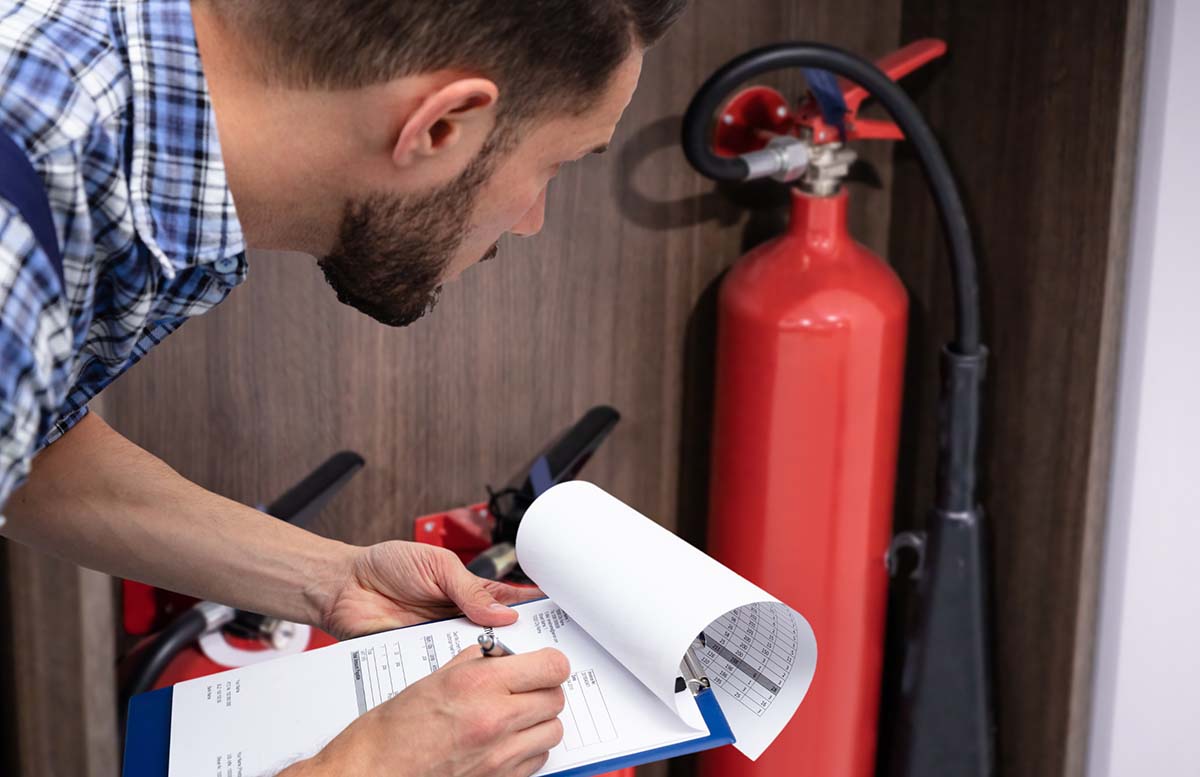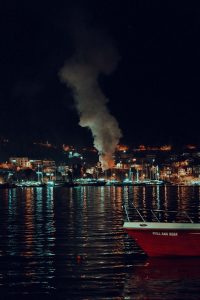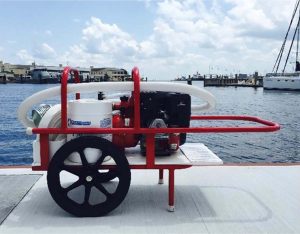
Fire Prevention Essentials for Marinas
Published on April 1, 2025Marinas are powder kegs — rife with flammables, combustibles and recreational vessels at the mercy of one errant spark, one disregarded electrical code or one untrained staff member. When fire strikes, it can spread 100% or double in size every minute — a terrifying and potentially catastrophic rate. Marina staff and guests must be prepared and know how to respond in an organized and efficient manner.
Fortunately, there are ways to diminish risk and plan for any worst-case scenario. This includes an understanding of fire sources, codes and standards, preventative measures, equipment and infrastructure, as well as a commitment to staff and boater education.
Common Sources of Fires
The first step to understanding fire risk is understanding common fire causes.
Electrical systems are a frequent culprit, namely when electrical work is not performed to code. Transformers, substations, shore power cords, power pedestals and other electrical system components should follow electrical codes set forth by the National Electrical Code (NEC) / NFPA 70. Published by the National Fire Protection Association (NFPA), Article 555 of the code sets the standard for proper wiring, voltage, ground-fault protection, surge protection and more — specifically at marinas and boatyards. Marinas should not only adhere to these national standards but follow best practices for ensuring electrical systems are weatherproof, corrosion-resistant and situated safely above the water mark. Electrical work should be designed and conducted by a licensed electrical engineer and inspected annually.

Improper storage of flammables such as gas, diesel, oil, grease, lithium batteries or oil-based paints, thinners and varnishes are also a problem. These should all be stored in approved containers and designated closed-door cabinets with proper signage to alert not only employees but firefighters to their location. This includes soiled rags or miscellaneous flammables often kept in dock boxes by marina guests.
Private boater amenities are also a common source of fires. Electric heaters, faulty extension cords and unattended grills and appliances can overheat or spark, triggering small fires that quickly escalate into something much more serious.
Codes and Standards
National Fire Protection Association (NFPA) Code 303: Fire Protection Standard for Marinas and Boatyards sets the standard for fire protection. It should be well understood and thoroughly implemented in order to be effective.
While NFPA Code 303 sets the overarching standard, there are myriad state, municipal and local codes and best practices to adhere to as well. These include OSHA maritime standards, NEC electrical codes and varying local building, fire and electrical codes. Marinas should inquire about the local and state codes impacting them and plan accordingly.
Fire Prevention Measures
Annual inspections are a simple way to prevent fires at marinas and boatyards. Who conducts these inspections varies from jurisdiction to jurisdiction but might include local fire departments or city utility departments. A comprehensive inspection should include checking the functionality and location of fire extinguishers, water sources, flammable storage areas, dock and boat infrastructure, communication systems, fuel dispensing and storage systems, electrical wiring and emergency response plans. Inspections should also be conducted within any on-site buildings or restaurants.

It is important to have a fire suppression plan and emergency response plan in place. The fire suppression plan identifies and maps the location of fire-suppressing equipment such as standpipes, hydrants, extinguishers, hoses, pumps, cabinets, etc. The plan should also identify the location of flammable areas such as fuel tanks, lines and storage areas. It is a great idea to include a map with overlapping or concentric circles to demonstrate the coverage areas of each fire suppressant and identify any gaps in coverage.
The emergency response plan serves as a companion to the fire suppression plan. This is an action-oriented document, designed to name specific people responsible for emergency response activities, establish communication protocols, identify evacuation routes and safety equipment and include contact information for local emergency response departments.
However, even the best-laid plans and equipment are worthless without education on how to use them. Staff and boater education is paramount to marina safety and fire response. Marina owners and managers should hold frequent training and refresher courses about the common sources of marina and boat fires, proper fire extinguisher use, the location of fire-suppressing equipment and a review of the marina’s emergency response plan. Educational signage around the property can serve as easy, inexpensive reminders to keep the information top of mind.
Design and Equipment
When designing marinas for optimal safety, it’s all about having the right infrastructure, utility systems and safety equipment in the right places. This begins early in the design stage of a project.

A knowledgeable marina designer will lean on the American Society of Civil Engineers (ASCE) Planning and Design Guidelines for Small Craft Harbors — aka Manual 50 — to inform the safe sizing, spacing and location of docks, slips, navigational channels, gangways and land-based support facilities. A designer will then work with licensed engineers and reference NFPA Code 303 for standards pertaining to the type, sizing and spacing of fire-suppression and safety equipment within the marina. This includes specifications for electrical safety, operational safety, storage protection and life safety systems.
One common blunder in marina design includes the unsafe composition and location of fuel tanks and fuel lines. These systems should always be located above the high-water mark and housed in PVC or other non-metal, marine-grade material to prevent corrosion and UV degradation. Fuel lines should run along designated fuel dock pathways, within clearly marked conduits or channels, away from potential hazards such as boat propellers.
Another example of safety oversight is in the selection of fire extinguishers. These need to be the correct size and type for the flammables at hand, inspected annually and spaced according to NFPA Code 303 standards per dock length and slip count. For most situations, Class ABC Dry Chemical Fire Extinguishers should suffice. These are multipurpose and effective in fighting combustible-based solids such as wood, paper and cloth; flammable liquids such as gas, diesel, oil and grease; and electrical fires. Marinas hosting electric boats, on the other hand, may need a different or more robust chemical extinguisher depending on what type of battery the electric boat utilizes. That said, extinguishers are only as effective as they are employed, so training staff and boaters in how to properly use them is essential.
Marinas should also select the right type of fire hydrant for their location and consider adding an on-site firefighting pump for optimal protection.
Hydrants are categorized as either “wet” or “dry,” each with their own benefits and applications. A wet hydrant holds pressurized water inside its barrel at all times, which means it can provide an instantaneous flow of water when opened. This standing water can lead to freezing and other issues, however, which makes it less suitable for marinas in cold environments. A dry hydrant drains water out of the barrel when not in use, resulting in a less-instant flow, but without the same issues of freezing as a wet hydrant. It is an unpressurized hydrant, often used in locations where the municipal water system is less easily accessible and utilizes either water supplied by the fire truck or the nearby lake or river.
On-site firefighting pumps are some of the latest innovations for fire suppression at marinas and are highly effective in immediately responding to fire at its source — either putting it out directly or slowing the spread until the fire department arrives.
The Fast Attack III by EMP Industries is a portable pump with a 15-foot filtered hose that suctions water from beneath the dock into a self-priming 10 horsepower pump. The pump then delivers a stream of water fortified with environmentally friendly firefighting foam at a rate of 100 gallons per minute. This can reach a distance up to 100 feet with a force of approximately 100 pounds per square inch, which keeps the operator away from smoke and heat. This amount of pressure is in alignment with pump performance requirements of NFPA Code 303.
This system doesn’t rely on hydrants; it uses the water source at hand. The Fast Attack sits on two wheels for easy maneuverability but can also be mounted on a golf cart for even faster application or skid-mounted with handles on each side for use in the back of a truck bed. All told, the system weighs approximately 250 pounds and is considered a turnkey, ready-to-use system at a base price of $11,000, which includes a maintenance program. EMP Industries is able to conduct staff training in some locations and can help marinas put together a fire suppression or emergency response plan with the integration of the pump.
Dan Williams, PLA, ASLA, AHLP is senior landscape architect at MSA. He can be reached at dwilliams@msa-ps.com. Marcus Rue, PE is project manager at MSA. He can be reached at mrue@msa-ps.com. Aaron Kravitz is sales representative at EMP Industries, Inc. He can be reached at akravitz@empind.net. Randy Ward, CMM, is a marina safety consultant. He can be reached at rward51@comcast.net.
| Categories | |
| Tags |





